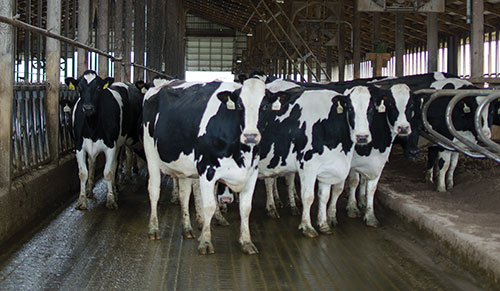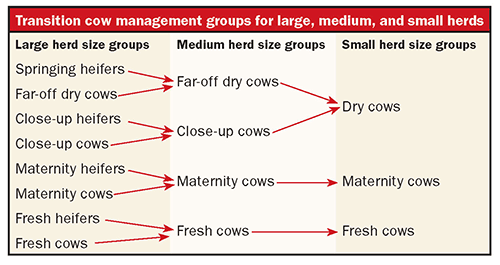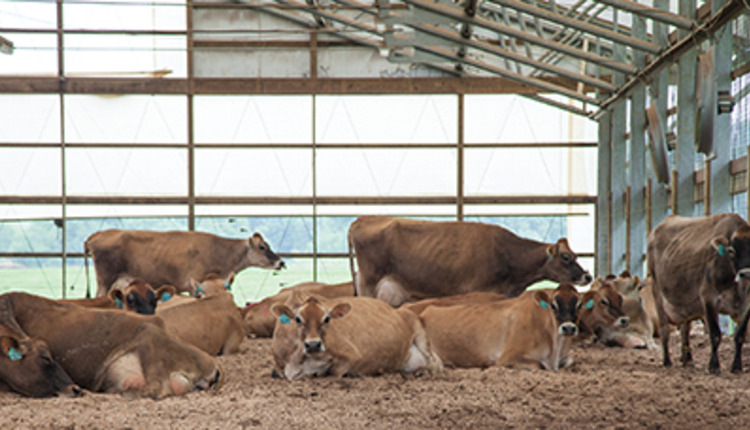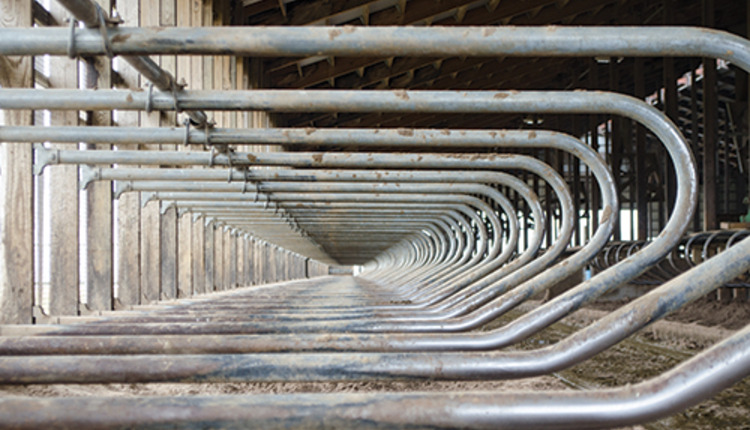The authors are a veterinarian who helped design Fair Oaks Dairy and Central Sands, and a professor of biological systems engineering at the University of Wisconsin-Madison.

Moving cows may invoke different levels of stress and, ultimately, impact performance. When cows are in a pen with an established social order, moving them into another social group has the detrimental effects of reducing feed intake and resting time.
And not all groups are equal. A group size of less than 100 cows has a social group and social order (ranking) within the group. A group size of 200 cows has two social groups and social orders (rankings) within each one. When moving cows that are part of a large (more than 250 cows) group, no social rankings exists and there is a little or no effect on feed intake, resting time and performance.
After the individual pens are sized, the next step is to arrange the pens in a facility layout that will fit the building space. Lactating cow pens should be located as close to the parlor as possible, whereas pens for far-off or close-up cows can be placed further away. Bedded pens will require access for cleaning the bedded resting area without moving through freestall pens and usually are best located at the ends of the building.
Additional design and layout considerations will be manure handling system flow, feeding access, cow movement and transition cow facility design elements. Needs vary from herd to herd, throughout any given year and, also, throughout the life of a dairy.
Facilities should be designed with thought of how staff will carry out cow care and movement throughout the pens. Remember, this is where the herd manager and veterinarian will be spending most of their time. It is extremely important that working conditions are convenient for them to make the most efficient use of their time.
Restraint and people passes. For large group pens, headlocks are the most common system. In individual pens, strategically located gates can create a funnel to allow a person to maneuver a cow into the headlock easily.
Safety passes or personnel passes should be available in all pens. A gap between the bottom rail of the fence or gate and the floor will allow a person the opportunity to roll away from an aggressive animal.
Drover lane. Alleys or drover lanes are another feature that can make moving cow groups from pen to pen easier. With a well laid out pen system and a drover lane, one person can move and manage cows. The drover lane is placed adjacent to a series of group pens along the length of the building so that any pen can be accessed.
This is an especially important design feature for large herd barn designs with multiple pens in the length of the barn. The drover lane allows cows to be moved from one pen to another without disrupting the routine or needing to move cows through other pens.
Bud box. Cow movement with the ability for one person to move a cow from pen to pen should be a primary consideration in determining pen locations and drover lanes. The bud box design for moving cows into a pen from an alley or lane is one method that can make cow moving an easy task.
As the cow moves down the alley, she passes the pen that ultimately is her destination. As the person moving the cow walks past the destination pen, they close the alley gate, blocking the previous entrance. This gate also opens the destination pen the cow is to enter. When the cow reaches the dead end of the alley, her tendency will be to turn and return where she entered. The only option will be to enter the destination pen.
Worker safety. The facility design should be safe for not only cows but people as well. Worker safety considerations should also be part of the management and facility plan. Items to consider in the design include animal restraint measures, escape routes for workers from aggressive animals, elimination of pinch points or entrapment hazards between the worker and the animals, good footing for both workers and cows, and adequate lighting.
Herdsperson-veterinarian office. The herdsperson office should be near the transition cow groups because this is where a lot of their time will be spent with cows calving and monitoring health of the fresh cows. This office space can be located adjacent to the calving pens to allow easy access to a computer for records and observation of transition cows. This office may also be used by the veterinarian.
Newborn calf care. A space for working with the newborn calf should be located in a convenient place near supplies and equipment that might be needed to process the calf and get it ready for its new location. Access to hot water, cleaning supplies, towels, colostrum storage and other vet supplies would be desirable. In cold weather, a warm room and calf warming box may be necessary to dry the calf before moving.

A scaled plan or sketch of the facility design should be developed keeping in mind transition cow numbers and the overall herd size. The number of groups are outlined in the figure. The plan is used to communicate the transition cow facility features and specifications to the dairy team and the builder.
The scaled plan can be used to evaluate the overall design and its impact on all aspects of the transition cow management plan. The dairy design team can review and critique the design. The plan can be used to evaluate cow flow from pen to pen, feed equipment traffic, manure handling traffic and transition cow management protocols.
Click here to return to the Animal Care E-Sources
150525_369

Moving cows may invoke different levels of stress and, ultimately, impact performance. When cows are in a pen with an established social order, moving them into another social group has the detrimental effects of reducing feed intake and resting time.
And not all groups are equal. A group size of less than 100 cows has a social group and social order (ranking) within the group. A group size of 200 cows has two social groups and social orders (rankings) within each one. When moving cows that are part of a large (more than 250 cows) group, no social rankings exists and there is a little or no effect on feed intake, resting time and performance.
Arrange pens into the facility's design
After the individual pens are sized, the next step is to arrange the pens in a facility layout that will fit the building space. Lactating cow pens should be located as close to the parlor as possible, whereas pens for far-off or close-up cows can be placed further away. Bedded pens will require access for cleaning the bedded resting area without moving through freestall pens and usually are best located at the ends of the building.
Additional design and layout considerations will be manure handling system flow, feeding access, cow movement and transition cow facility design elements. Needs vary from herd to herd, throughout any given year and, also, throughout the life of a dairy.
Facilities should be designed with thought of how staff will carry out cow care and movement throughout the pens. Remember, this is where the herd manager and veterinarian will be spending most of their time. It is extremely important that working conditions are convenient for them to make the most efficient use of their time.
Restraint and people passes. For large group pens, headlocks are the most common system. In individual pens, strategically located gates can create a funnel to allow a person to maneuver a cow into the headlock easily.
Safety passes or personnel passes should be available in all pens. A gap between the bottom rail of the fence or gate and the floor will allow a person the opportunity to roll away from an aggressive animal.
Drover lane. Alleys or drover lanes are another feature that can make moving cow groups from pen to pen easier. With a well laid out pen system and a drover lane, one person can move and manage cows. The drover lane is placed adjacent to a series of group pens along the length of the building so that any pen can be accessed.
This is an especially important design feature for large herd barn designs with multiple pens in the length of the barn. The drover lane allows cows to be moved from one pen to another without disrupting the routine or needing to move cows through other pens.
Bud box. Cow movement with the ability for one person to move a cow from pen to pen should be a primary consideration in determining pen locations and drover lanes. The bud box design for moving cows into a pen from an alley or lane is one method that can make cow moving an easy task.
As the cow moves down the alley, she passes the pen that ultimately is her destination. As the person moving the cow walks past the destination pen, they close the alley gate, blocking the previous entrance. This gate also opens the destination pen the cow is to enter. When the cow reaches the dead end of the alley, her tendency will be to turn and return where she entered. The only option will be to enter the destination pen.
Worker safety. The facility design should be safe for not only cows but people as well. Worker safety considerations should also be part of the management and facility plan. Items to consider in the design include animal restraint measures, escape routes for workers from aggressive animals, elimination of pinch points or entrapment hazards between the worker and the animals, good footing for both workers and cows, and adequate lighting.
Herdsperson-veterinarian office. The herdsperson office should be near the transition cow groups because this is where a lot of their time will be spent with cows calving and monitoring health of the fresh cows. This office space can be located adjacent to the calving pens to allow easy access to a computer for records and observation of transition cows. This office may also be used by the veterinarian.
Newborn calf care. A space for working with the newborn calf should be located in a convenient place near supplies and equipment that might be needed to process the calf and get it ready for its new location. Access to hot water, cleaning supplies, towels, colostrum storage and other vet supplies would be desirable. In cold weather, a warm room and calf warming box may be necessary to dry the calf before moving.

Implement the design
A scaled plan or sketch of the facility design should be developed keeping in mind transition cow numbers and the overall herd size. The number of groups are outlined in the figure. The plan is used to communicate the transition cow facility features and specifications to the dairy team and the builder.
The scaled plan can be used to evaluate the overall design and its impact on all aspects of the transition cow management plan. The dairy design team can review and critique the design. The plan can be used to evaluate cow flow from pen to pen, feed equipment traffic, manure handling traffic and transition cow management protocols.
150525_369










